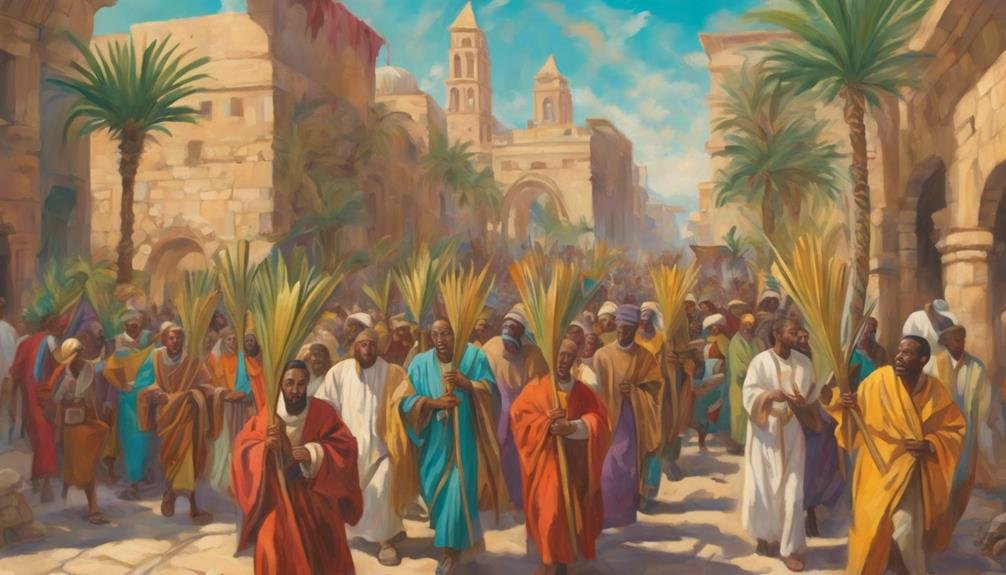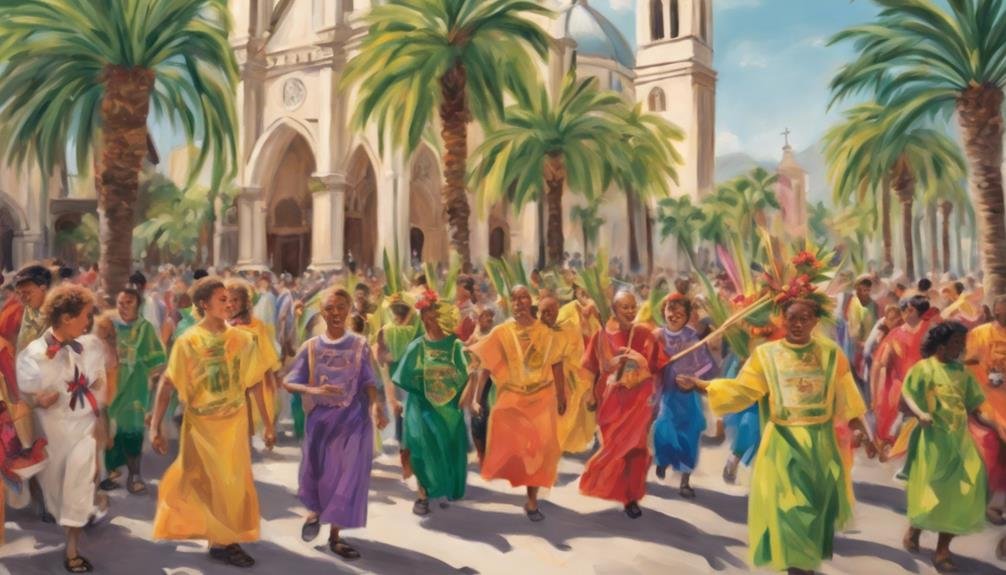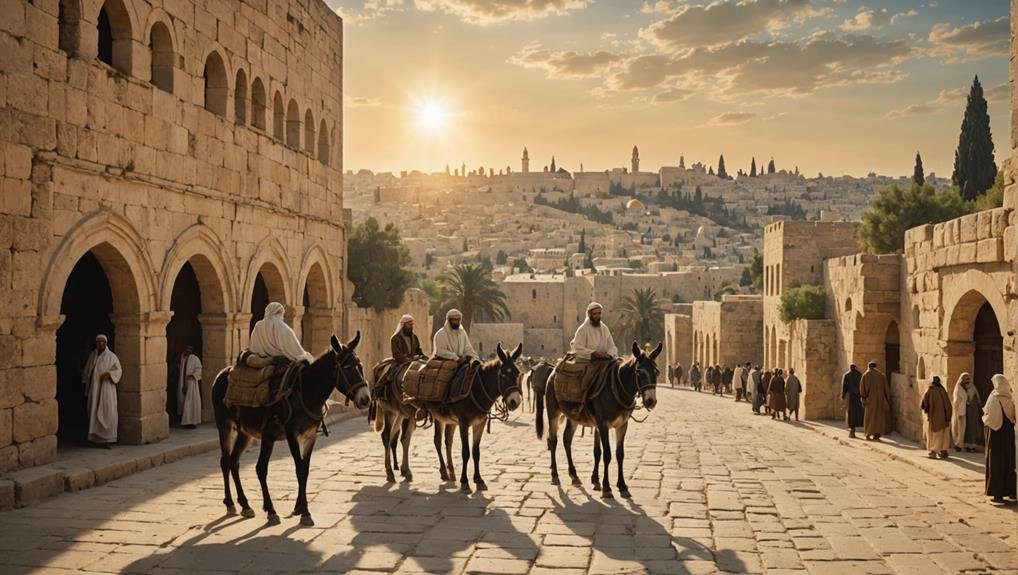When you think about Palm Sunday, you’re tapping into a tradition with roots deep in the late fourth-century Jerusalem Church. It marks Christ’s entry into Jerusalem, where early Christians once gathered with palm and olive branches, starting a ritual that transformed over centuries. But what led these simple beginnings to evolve into today’s complex ceremonies, from modest prayers to global traditions, is worth exploring, as each layer reveals how faith and culture intertwined to shape this sacred day. So, what’s the significance behind these palms, and how did this observance spread so widely?
Key Takeaways
- Palm Sunday originated in the late fourth-century Jerusalem Church, commemorating Christ’s triumphant entry into Jerusalem.
- It involves a procession with palm and olive branches, symbolizing victory and joy.
- Western Christianity adopted Palm Sunday practices by the 8th century and incorporated Passion readings into Mass by the 10th century.
- Celebrations have spread globally, featuring diverse regional traditions like palm crosses in Egypt and bouquets in Lithuania.
- Modern observances include blessing palms and creating palm crosses, symbolizing faith and protection throughout the year.
Origins in Jerusalem

Palm Sunday finds its roots in the vibrant rituals of the late fourth-century Jerusalem Church. During this time, the faithful gathered to commemorate Christ’s triumphant entry into Jerusalem, creating a spiritual journey that was both profound and communal. People took part in a procession, carrying palm and olive branches as symbols of peace and victory, echoing the biblical narratives of Jesus’ arrival.
These early ceremonies weren’t just simple gatherings but immersive experiences filled with prayers, hymns, and sermons.
As you walked with others, you visited various holy sites that held significance in Jesus’s life. The procession culminated at a particularly sacred location—the very place where Christ ascended into heaven. This final destination imbued the journey with a sense of completion and spiritual elevation.
Spread to Western Christianity
By the 9th century, the celebration of Palm Sunday had spread to Western Christianity, building upon its origins in the 4th-century Jerusalem Church. This tradition began to take hold in the Western Church by the 8th century. You can see how the historical roots of the celebration, which honored Jesus Christ’s triumphant entry into Jerusalem as prophesied in Zechariah 9:9, were embraced and adapted.
The Western Church adopted key elements from its century in Jerusalem, such as the blessing of palms and morning processions. These practices became integral to the Palm Sunday traditions and practices you see today.
The spread of Western Christianity didn’t just stop at adopting rituals; it also involved embedding the deep respect and honor Jesus received during His entry into Jerusalem.
Ceremonial Evolution

Over the centuries, Palm Sunday’s ceremonial evolution has showcased a rich tapestry of traditions that have grown more elaborate. In the late fourth century, the Jerusalem Church began with simple prayers and hymns to mark this day. By the fifth century, these modest beginnings had evolved into elaborate processions featuring palm and olive branches, symbolizing Jesus’ triumphant entry into Jerusalem and fulfilling Zechariah’s prophecy.
As the sixth and seventh centuries unfolded, new traditions like the blessing of the palms and morning processions emerged. These practices were later embraced by the Western Church in the eighth century, adding a distinct layer to the Palm Sunday ceremony. The celebration commemorates Jesus’ journey and incorporates the Passion into Mass, a tradition consistent since the tenth century.
The blessing of the palms remains a central element, with participants often taking the blessed branches home to display them prominently. In some countries, they’re even used to adorn graves, reflecting their significance beyond the church. These evolving traditions emphasized Palm Sunday’s deep-rooted history and shared meaning across diverse Christian communities.
Symbolism of Palms
The symbolism of palms on Palm Sunday is rich with meaning, embodying victory and joy as they welcome Jesus as a king. When you wave a palm branch during the procession, you participate in a tradition celebrating Jesus’ triumphal entry into Jerusalem. This act isn’t just ceremonial; it’s a profound expression of honor and recognition of Jesus as the Messiah.
In the biblical narrative, palms signify a peaceful yet triumphant entry, highlighting Jesus’ role as a figure of victory over sin and death. Remember its ancient symbolism of goodness and joy as you hold a palm. These branches were historically used to celebrate successes and special occasions, marking a moment of triumph.
On Palm Sunday, the symbolism extends beyond mere tradition. It’s a declaration of faith and acknowledgment of Jesus’ kingship.
The blessed palms you receive are more than just a souvenir; they remind you of Jesus’ journey and His ultimate sacrifice. As you participate in the procession, you commemorate His arrival and the hope He brings. Through this act, you honor His legacy and the profound victory He achieved for humanity.
Global Traditions

When you explore Palm Sunday’s global traditions, you’ll notice various cultural practices and unique regional celebrations. Countries without palm trees often use branches like yew or pussy willow for their rituals, showcasing local adaptations.
Each tradition adds flavor to the celebration, from the Hoegaarden procession in Belgium to Finland’s Easter witches.
Diverse Cultural Practices
Though Palm Sunday is widely recognized as a Christian celebration, its observance varies across cultures. In India and Ethiopia, Sunday traditions feature unique plant materials like neem leaves and interwoven palm fronds at various holy sites. In Egypt, Coptic Christians create complex palm crosses for vibrant processions. These cultural practices highlight the diversity of Palm Sunday celebrations.
In Lithuania, elaborate palm bouquets and festive markets are a tribute to local craftsmanship and community spirit. The Latvian community decorates willow branches with colorful ribbons, adding a touch of vibrancy to the celebrations. Meanwhile, olive branches in the Levant symbolize peace and prosperity, deeply rooted in Middle Eastern traditions.
Here’s a glimpse into these diverse traditions:
| Country | Unique Tradition | Symbolism |
|---|---|---|
| India | Neem leaves and interwoven palm fronds | Connection to nature |
| Ethiopia | Interwoven palm fronds | Cultural heritage |
| Egypt | Complex palm crosses and processions | Religious devotion |
| Lithuania | Elaborate palm bouquets and festive markets | Community and craftsmanship |
| Levant | Olive branches | Peace and prosperity |
These varied practices reflect the rich cultural tapestry that Palm Sunday weaves across the globe.
Unique Regional Celebrations
Across the globe, Palm Sunday unfolds in myriad ways worldwide, with each region infusing its cultural flavor into the celebration. Palm Sunday is celebrated in India in India with grand processions and vibrant palm leaf decorations. As you join these events, you’ll hear traditional hymns resonating through the air, creating a festive atmosphere.
Meanwhile, in Ethiopia, the day is known as Hosanna, which is marked by special liturgical rites and the making of palm crosses. Communal gatherings bring people together, fostering a sense of unity and shared faith.
Italy’s Poland m Sun Day traditions revolve around intricately woven palm fronds and olive branches in Europe. You’ll witness religious processions that carry a deep sense of history and spirituality.
In Egypt, Coptic Christians adorn their churches with palm fronds and olive branches, adding symbolic decorations that reflect their rich heritage. If you venture into Germany, Palm Sunday customs feature beautifully decorated churches, and processions are accompanied by the singing of heartfelt hymns.
Here’s a quick look at how Palm Sunday is celebrated in different regions:
- India: Grand processions and traditional hymns.
- Ethiopia: Hosanna liturgical rites and communal gatherings.
- Italy: Palm frond weaving and religious processions.
- Germany: Church decorations and hymn singing.
Modern Observances
Modern observances of Palm Sunday often include blessing palm branches in churches, marking a poignant start to Holy Week. This Christian tradition dates back to biblical times, commemorating Jesus’ triumphal entry into Jerusalem. As part of this tradition, many churches organize a procession where worshippers hold palms, symbolizing the branches laid before Jesus on that significant day. This event reflects on historical events and connects you with the deep-rooted customs of your faith.
During Palm Sunday church services, the focus is often on the spiritual significance of Jesus’ journey and the unfolding events of Holy Week. The palms blessed during these services aren’t just for the day; many people take them home to symbolize faith and protection throughout the year.
You might craft these palms into palm crosses, a popular tradition that adds a personal touch to your observance.
Modern Palm Sunday celebrations bring biblical times to life, allowing you to participate in a rich tapestry of history and faith. By engaging in these rituals, you honor the past and prepare your heart for the sacred days ahead in Holy Week.
Conclusion
As you’ve seen, Palm Sunday holds deep historical roots, starting in Jerusalem and spreading to Western Christianity. Its ceremonies have evolved from simple prayers to intricate rituals, highlighting the significance of palms as symbols of victory and peace. Across the globe, diverse traditions reflect its enduring impact. Modern observances continue to honor this pivotal event, inviting you to participate in these meaningful celebrations and connect with a rich tapestry of faith and history.
FAQs
What is the historical background of Palm Sunday?
Palm Sunday commemorates Jesus Christ’s triumphant entry into Jerusalem, an event recorded in the Gospels. It marks the beginning of Holy Week, leading up to Easter. In this event, people laid palm branches and cloaks on the road as Jesus entered on a donkey, symbolizing victory and peace. This act fulfilled the prophecy in Zechariah 9:9, where a king is described as entering humbly on a donkey.
Key Points:
- Commemorates Jesus’ entry into Jerusalem
- Begins Holy Week leading to Easter
- Fulfills Zechariah’s prophecy of a peaceful king
Why are palm branches significant on Palm Sunday?
Palm branches symbolize victory, peace, and eternal life in various cultures. On Palm Sunday, the branches represent the people’s recognition of Jesus as the Messiah and their hope for deliverance. Waving palms and placing them on the road signified honor and reverence as they welcomed him as a king who brought peace.
Key Points:
- Symbol of victory, peace, and eternal life
- Represents recognition of Jesus as the Messiah
- A sign of honor and reverence from the people
How is Palm Sunday observed in different Christian traditions?
Palm Sunday is observed with various customs across Christian traditions. Congregations in Catholic, Anglican, and Orthodox churches often receive palm fronds, which are blessed and carried in processions. Some churches re-enact Jesus’s entry with donkeys or special readings. The palms are later burned in many places, and the ashes are saved for use on Ash Wednesday the following year.
Key Points:
- Palm fronds blessed and carried in processions
- Re-enactments and special readings in some churches
- Ashes from palms used for Ash Wednesday

